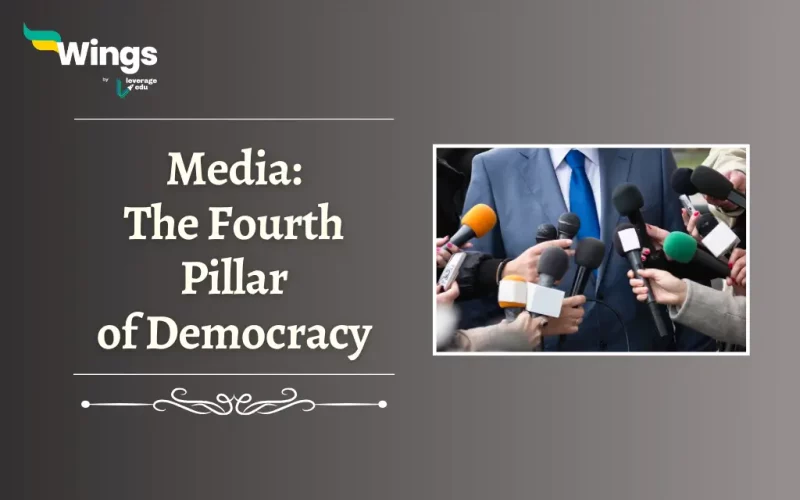Media is known as the fourth pillar of Democracy because it acts as a watchdog for the other pillars. It is known to provide credibility and maintain a check on the work and responsibilities of the Executive, Legislature and Judiciary. Additionally, the Media questions their authority from time to time and ensures the work is in favour of the public interest. Therefore, as aware citizens of a democratic country, Media is our closest window into the work of our Government structures. Moreover, citizens of India can maintain transparency with the system and also make their choices in public participation activities like elections.

Also Read: 11 Features of Democracy in India in Points
Functions of Media as the Fourth Pillar of Democracy
Table of Contents [show]
Democracy is a regime of people’s rule over their nation through their elected representatives. The Media is responsible for keeping a check on social, political and economic activities and informing the citizens about the same.
In addition, here are some top Functions of Media:
- Report electoral results and votes in each constituency.
- Highlight the progress or devastation incurred by various policies, parties and organisations.
- Likewise, covering agendas and campaigns of every election.
- It promotes the investigation of malpractices and illegal activities in the society or organisation.
- Moreover, by performing its role, it helps people to make an informed choice.
- The Media also showcases the competition between the electoral parties along with their claims and debates.
- Furthermore, it provides a platform for people to communicate their concerns and opinions freely. This could be sharing their views on a policy or putting forward their demands.
- Thus, it helps citizens in exercising their democratic rights.

Also Read: What is Patriotism?
Concerns Regarding the Power of Media as the Fourth Pillar of Democracy
With such immense power to enhance and influence public opinion, Media as the fourth pillar of democracy is a powerful tool that can also be misused. Here are some points of concern to note:
- Shading the news with opinion: The Media is expected to show an unbiased documented truth about a situation. When it gets shaded with one particular opinion, this can be used as a tool to manipulate the masses.
- Fact-checking: Media houses often remain in competition to break the news to the masses for TRP. However, this frequently results in a lack of fact-checking at the end of reporters creating huge confusion.
- Fundings for Media: Many organisations and political parties fund the Media houses. In this case, their opinion often becomes biased towards those who have their allegiance of interest. This results in compromised truths.
- The blurred walls of PR and news: Some people and organisations use media platforms for paid news, it is often seen under the featured content but as it appears on two or three platforms it eventually becomes news for the people. This makes it difficult to understand what is paid propaganda and the reality.
Also Read: Important Notes on the Impeachment Process
Types of Media
Media achieves its role as the fourth pillar of democracy, through two types of content, Print Media and Electronic Media.
Print Media
Print Media includes newspapers, magazines, books newsletters etc that were printed in hard form. The shifting of such content online has incurred a debate on what should be included in Print Media. Moreover, people can now find newspapers, magazines, newsletters and even books online. Furthermore, this has reduced the popularity of actual printed content which is evolving into e-libraries, newspaper apps and more.
Electronic Media
Electronic Media has everything from radio to video content, written content, etc. Every form of media that is available digitally is a part of digital or electronic media. Additionally, it is easy to share, maintain and produce in bulk without much need of resources. The transformation of reels to digital cameras and then mobile cameras has further narrowed the gap.
Also Read: Who Can Suspend the Fundamental Rights of Indians?
Freedom of Press
Our press has been granted freedom and it guarantees minimum interference of the State in the process of Media. The communication of the press with the people should be a free-flowing stream of information regardless of the platform.
However, this freedom should not be unchecked as that leads to the compromise of integrity. In case the sovereignty or integrity of the state is impacted, the freedom of the press or even the fundamental right to free expression is suspended.
Thus, this is the structure of governance of a democracy where every power must be kept in check for the benefit of public interest and to maintain peace and harmony within the country.

Related Blogs
Lastly, we hope you liked our blog and gained an understanding of the Fourth Pillar of Democracy. Moreover, you may even read more blogs and empower yourself with knowledge regarding Civics and Polity!
 One app for all your study abroad needs
One app for all your study abroad needs















 45,000+ students trusted us with their dreams. Take the first step today!
45,000+ students trusted us with their dreams. Take the first step today!
